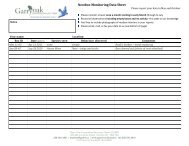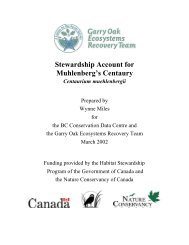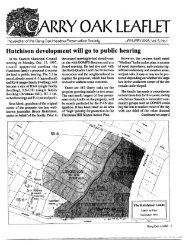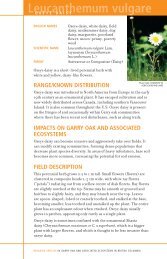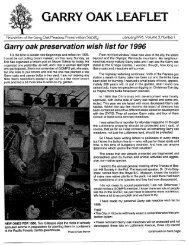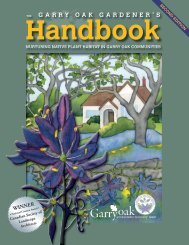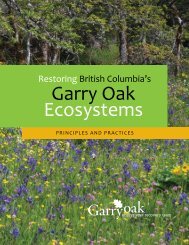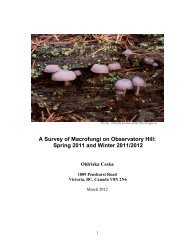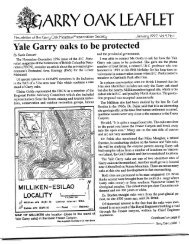Marah oreganus - Garry Oak Ecosystems Recovery Team
Marah oreganus - Garry Oak Ecosystems Recovery Team
Marah oreganus - Garry Oak Ecosystems Recovery Team
Create successful ePaper yourself
Turn your PDF publications into a flip-book with our unique Google optimized e-Paper software.
<strong>Marah</strong> <strong>oreganus</strong><br />
English names Oregon manroot, coast manroot, bigroot, western<br />
wildcucumber, old man in the ground<br />
Scientific name <strong>Marah</strong> <strong>oreganus</strong><br />
Family Cucurbitaceae (Gourd or Cucumber)<br />
Other scientific names Sicyos oregana, Megarrhiza oregana,<br />
Echinocystis oregana, Micrampelis oregana<br />
Risk status<br />
BC: critically imperilled (S1); red-listed<br />
Canada: imperilled/vulnerable (N2N3); COSEWIC: not yet assessed<br />
Global: secure (G5)<br />
Elsewhere: California, Oregon, Washington, Idaho – reported (SNR/SU)<br />
Range/known distribution<br />
Oregon manroot ranges from<br />
southwestern British Columbia<br />
south to northern California,<br />
primarily west of the Cascade<br />
Mountains. Infrequently, it is<br />
found as far east as the Snake<br />
River on the border of Oregon<br />
and Idaho. Although there have<br />
been reports from Montana,<br />
Nebraska and Wyoming, these<br />
are likely based on misidentification.<br />
In British Columbia, the distribution<br />
of Oregon manroot is limited to<br />
southeastern Vancouver Island<br />
and the Gulf Islands. There are<br />
3 known occurrences, 1 on the<br />
Saanich Peninsula, a second on<br />
North Pender Island, and a third<br />
on Saltspring Island. It has been<br />
extirpated from 1 site on South<br />
Pender Island.<br />
Distribution of <strong>Marah</strong> <strong>oreganus</strong><br />
l recently confirmed sites<br />
l extirpated site<br />
Species at Risk in <strong>Garry</strong> <strong>Oak</strong> and Associated <strong>Ecosystems</strong> in British Columbia
<strong>Marah</strong> <strong>oreganus</strong><br />
Field description<br />
Oregon manroot is a climbing perennial vine that grows from a woody,<br />
tuberous root. In mature plants, the scaly, tan-coloured tuber can be<br />
several meters long. One to several stems grow from the root, each up<br />
to 6 metres long. The stems trail on the ground or climb over other<br />
vegetation with branched tendrils. The leaves are large (up to 20 cm<br />
long), alternate and shallowly lobed with a heart-shaped base. The<br />
whitish flowers are 6-12 mm across, bell-shaped, with 5-8 petals. The<br />
male flowers are borne in clusters from the leaf axils and the solitary<br />
female flowers occur on short stalks at the base of the male clusters.<br />
The fruit are green, weakly spiny gourds, 4-5 cm in diameter with an<br />
average of 3-4 large (16-22 mm) seeds inside.<br />
Identification tips<br />
The wild cucumber (Echinocystis lobata), which is native to eastern North<br />
America, has been introduced to southcentral British Columbia. The wild<br />
cucumber has globe-shaped fruits and rough seeds whereas Oregon<br />
manroot has spherical to football-shaped fruit and smooth seeds.<br />
<strong>Marah</strong> <strong>oreganus</strong><br />
Matt Fairbarns<br />
Species at Risk in <strong>Garry</strong> <strong>Oak</strong> and Associated <strong>Ecosystems</strong> in British Columbia
<strong>Marah</strong> <strong>oreganus</strong><br />
Life history<br />
In British Columbia, Oregon manroot flowers in April and May and the<br />
vines are green with ripe fruit in mid-summer. It is not known when the<br />
shoots emerge from the tuber: in California, Oregon manroot begins<br />
growing in November/December whereas in Washington and Oregon,<br />
shoots emerge in early spring.<br />
Studies in California have shown that Oregon manroot is self-incompatible<br />
and must cross-pollinate in order to set fruit and produce seed. Pollinators<br />
are probably honeybees* (Apis mellifera) and smaller native Californian bees<br />
(Ceratina spp.). Gravity, water, and rodents are known to disperse seed<br />
and burial by rodents may improve germination success. In California, seeds<br />
germinate in March after a period of cool, moist weather. After the seeds<br />
germinate, the shoot grows downward into the soil and splits into one<br />
part that swells to form the tuber and a second part that grows back to the<br />
surface to become the vine.<br />
The root of Oregon manroot has multiple buds that can produce new<br />
plants if the root is broken into pieces. The multiple buds allow the plants<br />
to withstand limited mowing or grazing if there are sufficient stored food<br />
reserves in the root. Oregon manroot is probably a long-lived plant and<br />
may persist for decades or even centuries.<br />
Habitat<br />
In British Columbia, Oregon manroot grows on south-facing rocky slopes,<br />
both in deeper soil among rock outcrops and at the edges of mixed<br />
woodlands. All of the extant and historic populations are at low elevations,<br />
less than 30 meters from the ocean. One of the extant populations occurs<br />
on a low bank below a roadside that is dominated by invasive hedge<br />
bindweed* (Convolvulus sepium) and exotic shrubs. The two other extant<br />
populations occur with mixed <strong>Garry</strong> <strong>Oak</strong> (Quercus garryana) and Douglasfir<br />
(Pseudostuga menziesii) on coarse talus slopes or rocky bluffs with<br />
scattered shrubs such as Nootka rose (Rosa nutkana), common snowberry<br />
(Symphoricarpos albus) and oceanspray (Holodiscus discolor). The forb layer<br />
consists of both native and invasive herbs and grasses. The extirpated<br />
population occurred in a cleared pasture that has been overgrown with a<br />
second-growth forest of Douglas-fir, western red-cedar (Thuja plicata) and<br />
red alder (Alnus rubra).<br />
Why the species is at risk<br />
All of the British Columbia populations occur in habitat that is highly<br />
fragmented by development, invasive species and forest encroachment.<br />
Fire suppression has changed the composition of potential habitat.<br />
Although established Oregon manroot plants appear to be able to survive<br />
Species at Risk in <strong>Garry</strong> <strong>Oak</strong> and Associated <strong>Ecosystems</strong> in British Columbia
<strong>Marah</strong> <strong>oreganus</strong><br />
in degraded ecosystems, competition from invasive species for rooting<br />
space, soil moisture, and nutrients may limit the germination and survival<br />
of new plants. No seedlings were observed in any of the British Columbia<br />
populations. Trampling and possibly grazing by deer and cattle can<br />
damage plants, cause soil compaction and alter hydrology. Although the<br />
remaining plants are large, in 2006 there were only 18 individuals. The<br />
small number of plants may have limited genetic variability increasing their<br />
vulnerability to environmental changes.<br />
What you can do to help this species<br />
Management practices should be tailored to the specific circumstances<br />
at the site. Potential management tools will depend on the specific<br />
circumstances and may require experimentation on artificially established<br />
populations prior to implementation. Before taking any action, expert<br />
advice must be obtained and no action taken without it. Please refer<br />
to the introductory section of this manual.<br />
Public and private landowners should be made aware of new populations<br />
of this species if they are discovered, and appropriate management<br />
practices suggested. Management needs include controlling invasive<br />
species and restoring habitat. Existing populations should be monitored<br />
on an ongoing basis to determine their viability, as well as for any<br />
negative impacts stemming from land development, grazing, altered<br />
hydrology and weed encroachment.<br />
References<br />
British Columbia Conservation Data Centre. Botany Program. 2008.<br />
Database containing records of rare plant collections and observations<br />
in the province of British Columbia.<br />
Burrill, L.C. Western Wildcucumber <strong>Marah</strong> <strong>oreganus</strong> (T. & G.) Howell.<br />
A Pacific Northwest Extension Publication. PNW 401. Oregon State<br />
University, Washington State University, University of Idaho.<br />
Donovan, M. 2009. Personal Communication. Botanist, Victoria, BC.<br />
Schlising 1969. Seedling morphology in <strong>Marah</strong> (Cucurbitaceae) related<br />
to the Californian Mediterranean climate. American Journal of Botany<br />
56(5): 552-561.<br />
For further information, contact the <strong>Garry</strong> <strong>Oak</strong> <strong>Ecosystems</strong> <strong>Recovery</strong> <strong>Team</strong>,<br />
or see the web site at: www.goert.ca<br />
Line art reprinted with permission of the University of Washington Press. Photograph reprinted<br />
with permission of Matt Fairbarns.<br />
© 2008 *Refers to non-native species.<br />
Species at Risk in <strong>Garry</strong> <strong>Oak</strong> and Associated <strong>Ecosystems</strong> in British Columbia




